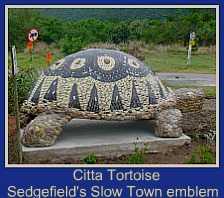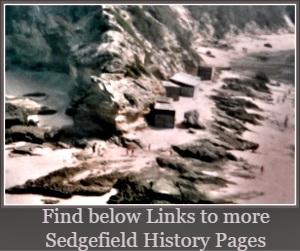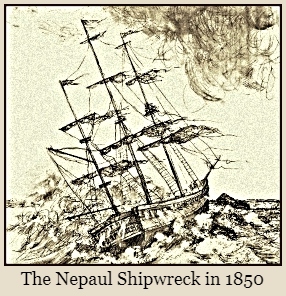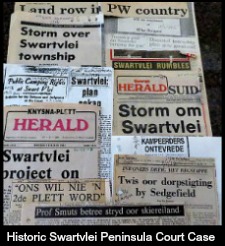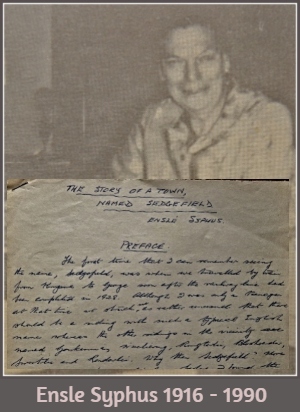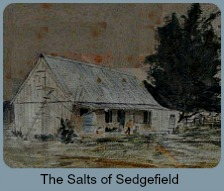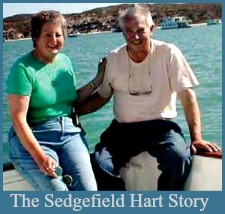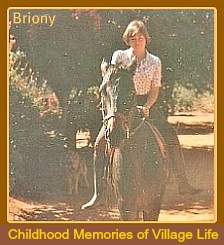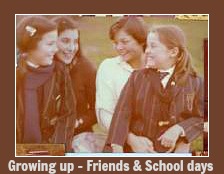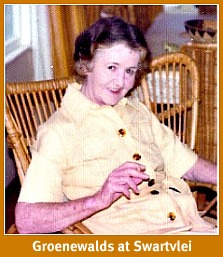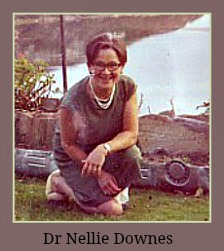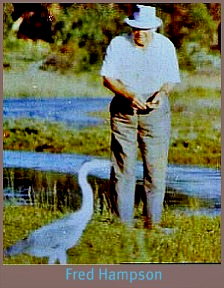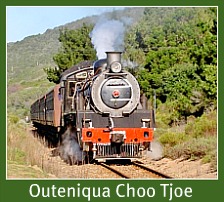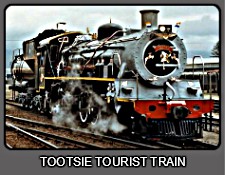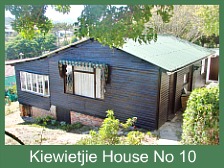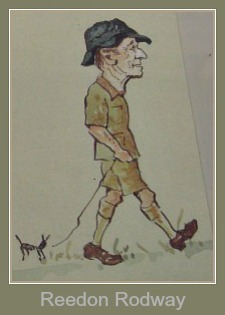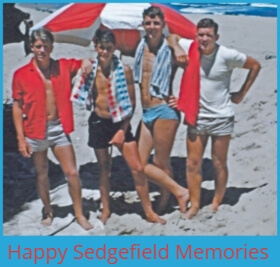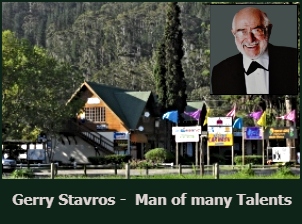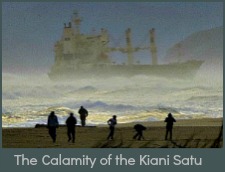The Swartvlei Campers
For over 200 years, generations of Swartvlei campers have trekked annually to the sheltering sand dune of the Swartvlei Peninsula bordering the Indian Ocean to rest from their labours and enjoy a sense of cameraderie and fun at the campsite next to the Swartvlei Lagoon. They came from the fertile valley of Goukamma, from Elandskraal, where the Barnards and Terblanches farmed, from Ruigtevlei and Eastbrook, the homestead of the Robertsons, George and even from as far inland as Oudtshoorn.
Many generations of Swartvlei campers endured arduous journeys driving their beasts of burden hitched to ox wagons and scotch carts while having to negotiate rutted gravel roads, deep sandy tracks over dunes and through drifts and finally, the tidal river of the Swartvlei, in order to spend their Christmas break at this campsite. Although many had big families, the nature of the terrain and the difficulties of communication meant people lived isolated lives, so this was an important time for creating a much needed sense of community.
From the early 1800s until the National Road was completed in 1951, the ox wagon was the main means of transport for farmers and their families.
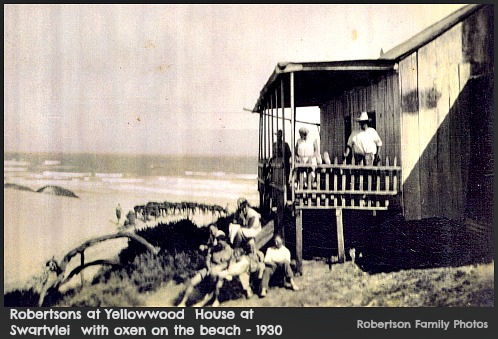
The Robertsons were one of these large families of Swartvlei campers that valued the annual break from the rigorous demands of farm life. Ridley(1913-1997) Robinson's family came from Ruigtevlei with his brother, Clem (Clarence) from Karatara and his wife Nellie (Booysen) and their children. They stayed in relative comfort in Ridley's double-storie house built of Yellowwood at the "nekkies", a place where a break in the dune field occurred, so that the house, overlooked the campsite and the ocean. Most of the families however, preferred to camp in bell or big marquee tents at the water's edge.
Weeks before the annual trip, the housewives were busy with their preparations. Rusks were baked, dried out and packed in linen bags. Meat was pickled and hung up to dry. Potatoes and onions were harvested and packed into bags. Then the wagons were loaded. There were large chests filled with mealie-meal, sugar, coffee and other foodstuffs. There were beds for the adults and household linen, cooking utensils for the women and fishing tackle for the men. A large can of vinegar, for the pickling of fish caught, was not forgotten.
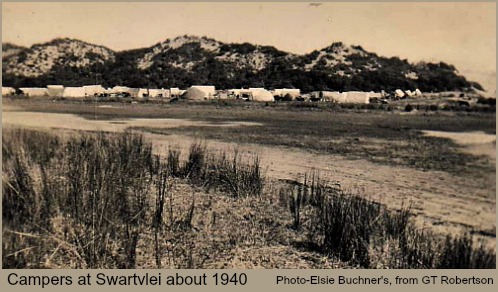
Nellie Robertson always took her black stove because her family loved her well-prepared, cooked meals. Some servants went along. The herd boys had to drive the cows and a few sheep, while fowls were transported in crates on the wagons.
Clem Robertson and his family left at 4 o'clock in the morning and if they had no mishap along the way, they outspanned at Jan Sak's shop for breakfast near the low water bridge at Ruigtevlei. (Today it's the T-junction that's at the turn off to Karatara/Barrington.) From there they had to go over Hooper's Hill but the track was so steep and sandy that at least 20-30 oxen had to be inspanned in the wagon and 10 in front of the lighter two-wheeled scotch cart.
The assistance of extra drivers was required to prevent the oxen from making a quick right-about-turn back to Ruigtevlei because that could break the dusselboom (shaft) of the ox wagon. Then it was slow motion down Hooper's Hill, past Meedingsride where Chartris Hooper lived (known more recently as the property where Casper Schmidt, the builder lives) reaching at last, the mouth of the Swartvlei Lagoon.
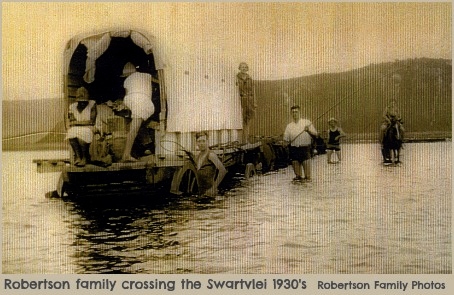
The farmers were relieved if the mouth was closed and they could cross at the sandbar, travel along the beach, over the nekkies (the break in the sand dune) to their camping grounds (where the Provincial Swartvlei Caravan/campsite is today.)
When the mouth was open, the wagons followed a sandy track that went past Jan Wessel's house and over the Perdespruit to a point just south of the National Road Bridge today. The crossing of the Swartvlei could only be done at low tide because there were deep gullies that had to be negotiated and even at low tide, the oxen had to swim through them.
Once when there was a storm at sea, Ridley and his family had to wait 8 days before they could cross the lagoon with their two wagons. Generally 30 oxen instead of 16 were inspanned to draw the wagons through the water. Sparrie Barnard who had been living in Sedgefield since 1922 and whose father was a transport driver, supplied extra oxen, for a fee.
The crossing was marked by long wooden pegs because if the wagons did not follow the correct route, the wheels would disappear into a kind of quicksand which caused a major problem. Men who had already reached the campsite would come across on horseback to assist with driving the oxen. The women crossed in the wagons but they had to stay in the closed wagon tents and were not allowed to peep at the men because most of them took off their pants to keep them dry. The horses played such an important role in the crossing of the stream that it was given the name "Perdespruit".
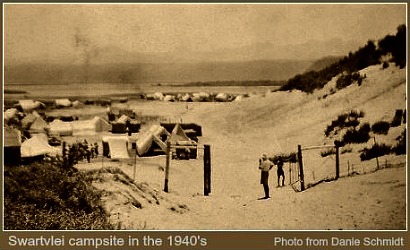
Once the camping grounds were reached and the oxen had been outspanned, the men would erect the tents while the servants made the fires and put kettles on to boil for the much desired cups of coffee. There were not many housewives like Aunt Nellie who had the convenience of a stove. Most of the cooking was done over open fires in big cast iron three-legged pots. The dough for bread for the Swartvlei campers was kneaded in the evening, allowed to rise overnight and then put in flat-bottomed cast iron pots and placed on glowing coals with some coals also on the lid. This gave rise to the name "pot-brood" and baked that way was far more tasty than oven baked bread. This was also the case with freshly caught fish that was fried on the coals, especially galjoen!
The camping grounds that had been in use for +/- 100 years by this time, were visited annually by at least 30 wagons and many more tents. Many families had 6 to 15 children so there was a good crowd of relatives and friends. Each family supplied its own needs as far as food was concerned but fresh water was a problem as the nearest fresh water was a fountain near the mouth of the Swartvlei.
Ridley Robertson became the transporter of fresh water. Early every morning, he sent one of his wagons with many huge barrels on board, over the nekkies to the fountain to collect fresh water to supply each day's needs for the Swartvlei campers.
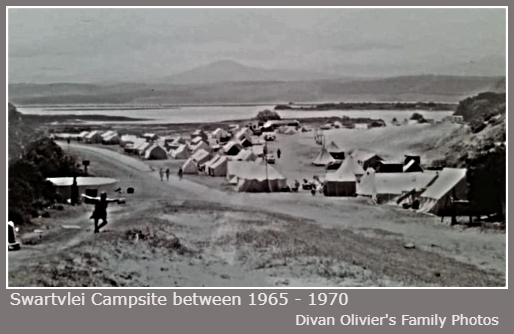
With many children in the camp, after breakfast, Nellie Robertson who was one of the first teachers in Sedgefield, gathered together between 30-40 small children and either went to the beach or into the lagoon, to teach them how to swim.
Although admitting she was not a strong swimmer herself, she would stand waist deep in the Swartvlei lagoon and tell the children to swim towards her and then, back to shore. If they were bathing in the sea, she was always alert. As the waves broke over her large flock, she would count all the little heads to check that they were all still there.
The men preferred to bathe in the nude so they had someone standing "cavey" at the nekkies while they were braving the waves. The same happened when it was bathing time for the women.
When the men were not fishing they took part in all kinds of boere-sport. There were races for old and young: tug-of-war, target shooting, bag races, horse races, long and high jump. Specifically for the children there were 3-legged races, egg and spoon races, leap-frog and others.
At some stage, the men participated in a "short target" competiton with a 22 rifle, that lasted the whole day. Clem Robertson donated an ox to the Swartvlei Campers for the competition but generally won it back and then gave it to them so that a huge braaivleis could be whole-heartedly enjoyed that night by everyone.
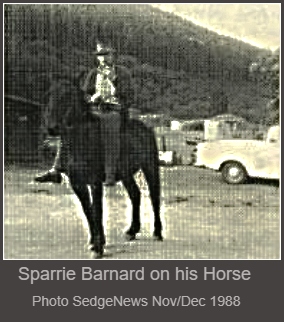
One year, there was a disturbing element in camp, a certain Mr B appeared, trotting around the camp on horse-back and telling everyone, especially the girls, what a wonderful grand horse he had! Everyone was getting tired of the braggart when Walter Muller who was a good sprinter, conceived of the idea to bring him down a peg or two. Walter challenged him to a race, he would run against Sparrie's horse. Walter chose the place and the distance as well. Everyone in the camp turned out to watch the-man-versus-the-horse race. Who won? Walter did of course! With the laughs of the crowd ringing in his ears, Mr B. could only slink out of camp, on his horse.
There was another Mr Barnard from Goukamma who had a portable "His Masters Voice" grammaphone that had to be rewound manually after every record played. Some of the songs that were played were "Red River Valley" and "When the Roses bloom Again". The Swartvlei campers danced to these lively tunes on the beach at night. When they tired of the canned music, the Barnards, a threesome, would supply music with a concertina, violin and guitar.
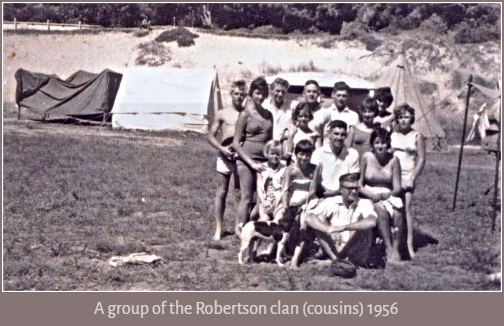
At Christmas, special parties were organised for the children. One of the favourites was a Fancy Dress Ball held on the grass around the tents. With meagre material at their disposal, the mothers were quite ingenious with the costumes they concocted. A large colourful beach towel and a scarf could turn a little girl into an Eastern princess. One child wanted to look like a flower basket so she was incased in a carton held in place with a wire over her head. When the carton was filled with flowers from the surrounding dunes, it was so heavy that it hurt the girl's head and she complained to her mother who responded with, 'If you want to look pretty, you must grin and bear it!"
On Christmas Eve, a group of the Swartvlei campers went from tent to tent singing Christmas Carols. On Christmas morning a church service was held under the Milkwood trees in the camp. Everyone was expected to attend. It was seldom that there was a dominee or parson available so an Elder of the Dutch Reformed Church conducted the sermon.
In the early days, sometimes old Mr Muller would make the journey from Meiringspoort in a mule wagon. It was a journey that would take several days. In later years, Oom Piet Theron conducted the services.
Old year's night was the night for dancing and much jollification in the camp but on the stroke of half-past eleven, all dancing stopped, and everyone gathered round for the midnight service held by Oom Piet. One year, one of the musicians was still softly strumming his guitar during the service. Willem Barnard could not stand the perceived irreverence, so he got up quietly, walked up to the guitarist, grabbed the guitar and bashed it to pieces over the offender's head. After the laughter had subsided, the service was completed and dancing commenced again until the early hours of New Year's Day.
Swartvlei Campers continue the Tradition
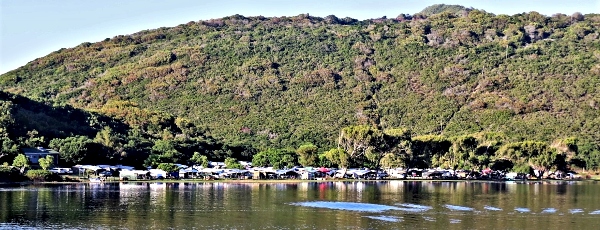 Swartvlei Campers Annual traditional trek to the Campsite for the Christmas break.
Swartvlei Campers Annual traditional trek to the Campsite for the Christmas break.Nowadays, younger generations of the old campers come from the length and breadth of South Africa to continue the tradition of camping at the Swartvlei at Christmas. Everyone knows each other.
The only permanent buildings are the ablution facilities but in every other way, it remains simplistic and yet it has everything they need. Only half the campsites have electricity but the Swartvlei campers like it that way.
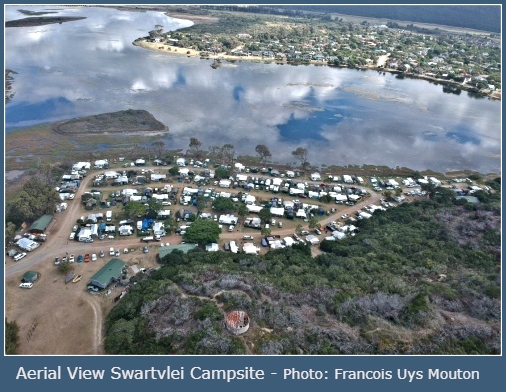
It's a big "family" get-together where they can catch up with each other's lives and have fun at the same time. The campsite that looks so over-crowded at ground level looks so neat and organised from the aerial view (Dec 2019).
The beach is a mere 100 meters behind the dune and the Swartvlei Lagoon is outside their tents: boating, canoeing, fishing, stand-up paddling, snorkelling, surfing, beach walks, swimming, beach volleyball are all in the offing and long chats around the fire while the men braai the meat at night. They hold competitions for Mr and Mrs Swartvlei and for the younger ones and still a good many games are enjoyed.
Today the campsite is managed by the Garden Route District Municipality and it is one of their most profitable campsites. Despite the fact that it is choc-a-bloc at Christmas time, that doesn't deter these Swartvlei campers one bit!
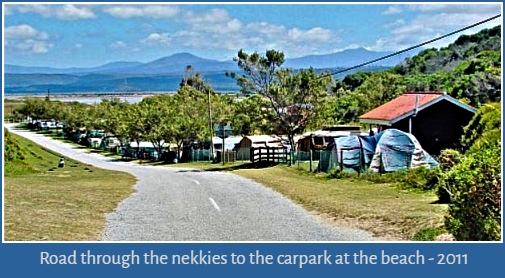
References
Ensle Syphus' Notes and her interview with Ridley Robertson
Photos sent to me by Trevor Robertson from his family photos
Photo from Daniel Schmidt, Casper Schmidt's son.
Aerial photo from Francois Uys Mouton (Swartvlei...the best times of my life!! Facebook)
Photo from Divan Olivier's family photos

